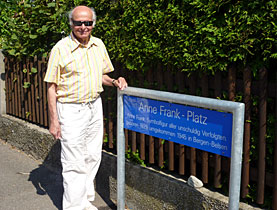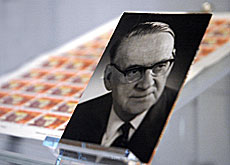Remembering Anne Frank

Had Anne Frank, who would have been 80 this year, survived the Holocaust, her Swiss cousin has no doubt that she would have become a writer and human rights activist.
Buddy Elias still lives in the Basel house Anne visited before she went into hiding in Amsterdam to avoid Nazi persecution. Since publication Anne’s diary recounting her wartime experiences has been read by millions.
Anne died in a concentration camp in 1945. After the war, her father, Otto – the only member of her family to survive the Holocaust – moved to Switzerland to be near his Swiss relatives. Birsfelden, the Basel suburb where he lived, has just unveiled an Anne Frank square.
“Anne and I were very fond of each other. She called me Bernd from my real name Bernhard and they visited several times and we played together,” Buddy Elias told swissinfo.ch over a cup of tea in his drawing room.
The room is full of pictures. On one wall hangs a painting of Elias’ mother Leni, who was Otto Frank’s sister, as a young child. There are photographs of Elias during his skating career – he worked for Holiday on Ice – and as an actor, a profession in which he is still active.
The 84-year-old also devotes a lot of time to the Anne Frank-Fonds, a Basel-based foundation set up by Otto Frank, which aims to keep Anne’s memory alive. He is her only living near relative.
A real character
Elias describes Anne as very funny and loveable, and more wild than her older sister, Margot. “I remember the last time Anne came to Basel she asked me to go to our grandmother’s wardrobe and put on one of grandmother’s dresses, a hat and shoes and imitate her,” he recalls with a smile.
“Well you can imagine how I looked in that dress, she had a lot of fun and laughed a lot.”
Like Anne, Elias was born in Frankfurt in Germany. His father became a rep for a German pectin firm in Switzerland before Hitler came to power, a move which Elias says saved the family.
It was Elias’ father who arranged for Otto Frank to become a rep of the same firm in the Netherlands, which at that time was believed to be safer for Jews than Germany. The Frank family moved to Amsterdam in 1933.
Anne received a diary on her 13th birthday on June 12, 1942 and immediately started writing. She documents her teenage worries, but it also becomes apparent that life was hard for Jewish families after the German invasion of The Netherlands in 1940. Anne had already moved to a Jewish high school.
Secret annexe
Otto decided to move the family into hiding after Margot received a call-up letter to report for relocation to a work camp. They and another family moved into a secret annexe of a house at Prisengracht 263 in July 1942, relying on the aid of several trusted helpers. Another man joined them later.
In her diary Anne records the daily tensions between the residents, how frightened she was about being discovered, and her budding romance with fellow annexe inhabitant Peter.
She also expresses her loneliness and frustrations. I know I’m far from being what I should, she writes at one point. Will I ever be?
Anne refers to Elias on two occasions. In October 1942 she dreams of going shopping in Switzerland with Bernd (the Franks always called him Bernd despite everyone else calling him Buddy). She even makes a list: three cotton vests @0.50=1.50, three cotton knickers…
In 1944 she reports that they have heard that Bernd has been on stage.
Last entry
Her last diary entry comes on August 1, 1944. A few days later the annexe was betrayed and the residents arrested. Anne and Margot died of typhus a year later in Bergen-Belsen. Their mother Edith died in Auschwitz.
Anne’s diary was rescued by two of the helpers and given back to Otto after the war.
“When I first read the diary I thought the same as Otto. Otto always said, ‘I didn’t know my daughter until I read her diary’ and it was the same with me.”
“I knew Anne as a funny, happy child with lots of imagination but I had no idea about the deep thoughts which were written in her diary, it was a revelation for me,” Elias said.
Anne talks about the condition of women and the folly of war. She also expresses a desire to become a writer or a journalist.
“I’m sure that she would have become a marvellous writer. She would probably have also been very active in humanism, working for the rights of women and children,” Elias said.
Publication
This wish to write was why, after a lot of thought, Otto decided to publish an edited version of the diary in 1947.
“Somebody once said that six million people murdered is statistics but one child that perished under these dreadful circumstances, people can identify with that. I still get many mails from people saying Anne’s diary has changed their lives. She shows people humanism and what discrimination can do,” Elias said.
The Anne Frank-Fonds, which has the rights to the book, uses the money to sponsor charitable projects that keep Anne’s ideas alive.
It was also behind the memorial to Anne and Margot in Bergen-Belsen, which has become one of the most visited parts of the site.
Later, we take a short drive to Birsfelden. On a villa in the Buchenstrasse, a plaque in German reads: “Otto Frank’s house. Anne Frank’s father lived here from 1964-1980” – the year of his death at age 91.
“Otto was very happy here, he had the garden, he had grapes at the back and he loved to sit out here with his second wife, Fritzi,” Elias said.
Anne’s square
Just a few steps away is the new Anne Frank square which was unveiled on June 7.
The square is the first full memorial devoted to Anne Frank in Switzerland – a situation which Elias had long been trying to change – and there are plans to turn it into a roundabout planted with a chestnut seedling donated from the Anne Frank Foundation in Amsterdam.
Elias reads out the inscription on the square’s blue sign: “Anne Frank, the symbol of all innocent persecuted people, born 1929 and died in 1945 in Bergen-Belsen”.
Then, according to the Jewish tradition, he places a stone underneath. It says, simply, “beloved and unforgotten. Bernd”.
Isobel Leybold-Johnson in Basel and Birsfelden, swissinfo.ch
August 4, 1944: Betrayal and arrest of the annexe residents. It is still not officially known who tipped off the German authorities. Buddy Elias believes that author Carol Ann Lee has found the culprit, now dead, a former member of the Dutch Nazi party.
August 8, 1944: Imprisonment in the Westerbork concentration camp in The Netherlands.
September 3-6, 1994: The Franks are transported on the last train from Westerbork to the Auschwitz concentration camp in Poland.
October 28–November 1 1944: Transfer of Anne and Margot from Auschwitz to Bergen-Belsen concentration camp near Hanover.
Late February – early March 1945: Margot dies of typhoid fever. Anne dies of the same disease a few days later. She is buried in one of the mass graves in Bergen-Belsen.
Source: Buddy Elias, Anne Frank-Fonds
Anne’s diary, kept from the age of 13-15, was meant to be personal. In spring 1944 she heard a broadcast by a member of the Dutch government in exile on collecting eyewitness accounts of the German occupation. After this she decided that she would later publish a book based on her diary and started editing her original.
After the war, Otto Frank decided to publish the diary using material from the original version and the amended version. He took out the bits which openly talked about sexual issues as this was considered too much at that time. He also omitted a few of the harsher passages about Anne’s mother – they did not always get on – as well as those about other annexe residents.
Otto Frank willed his daughter’s manuscripts to The Netherlands State Institute for War Documentation in Amsterdam. As the diary’s authenticity had been challenged, it ordered an investigation. It proved that the diary was indeed Anne’s work.
The Anne Frank-Fonds inherited Anne Frank’s copyrights. It issued a definitive version with 30 per cent more material in the 1980s.
Source: Anne Frank-Fonds

In compliance with the JTI standards
More: SWI swissinfo.ch certified by the Journalism Trust Initiative


You can find an overview of ongoing debates with our journalists here. Please join us!
If you want to start a conversation about a topic raised in this article or want to report factual errors, email us at english@swissinfo.ch.